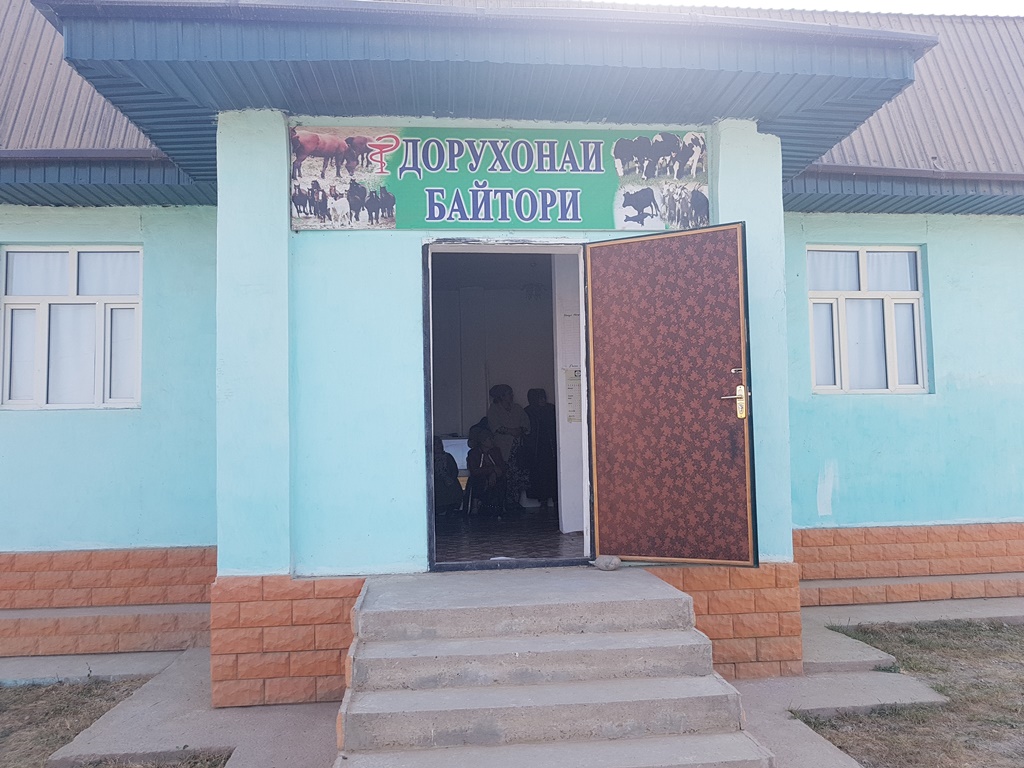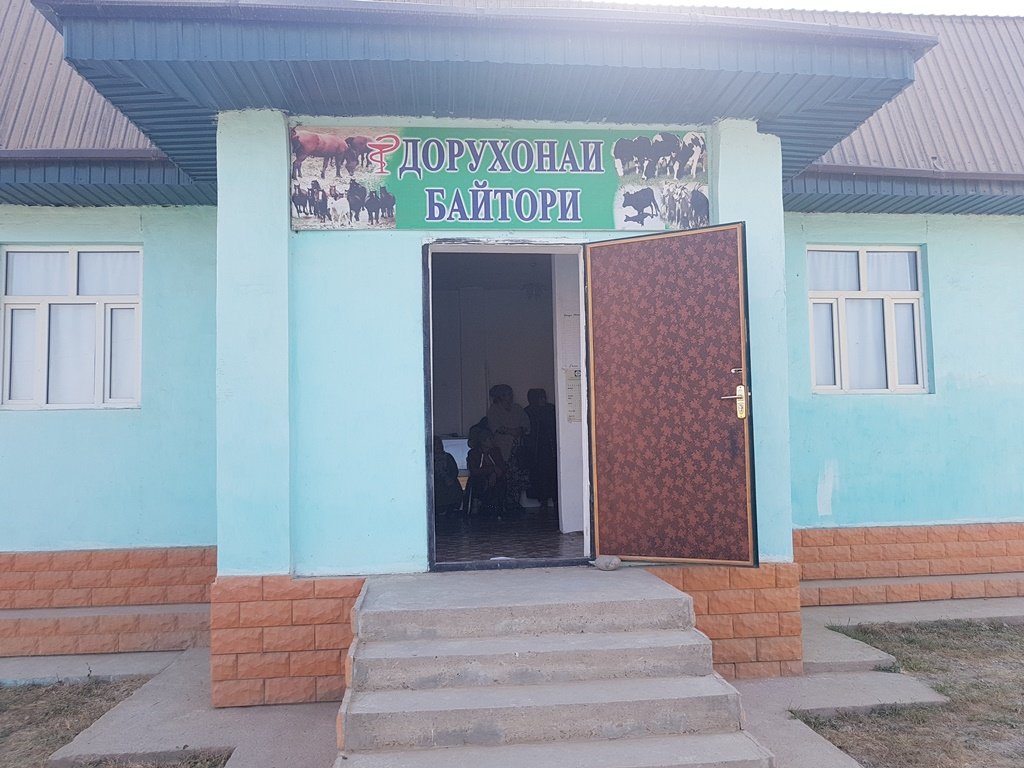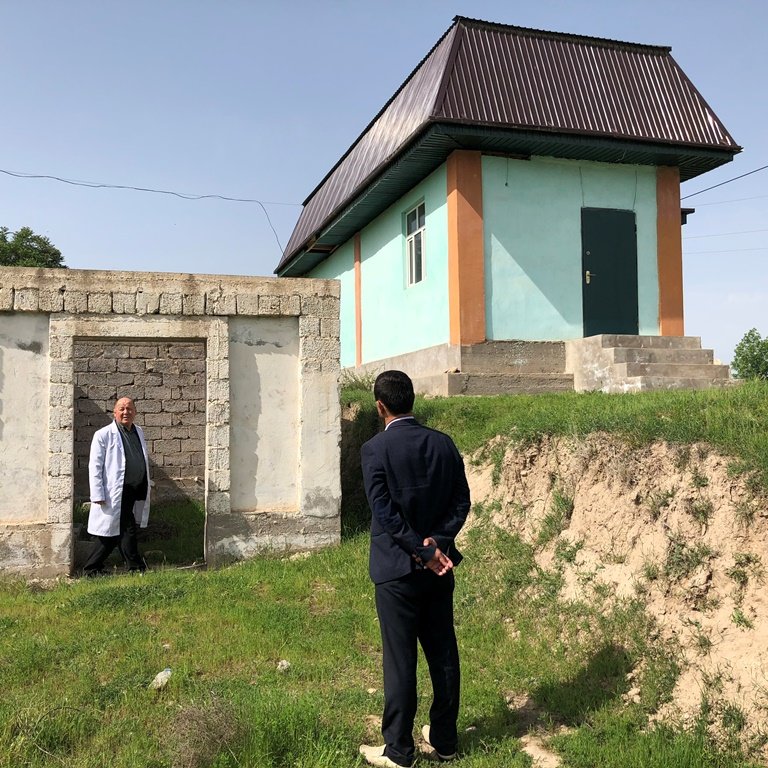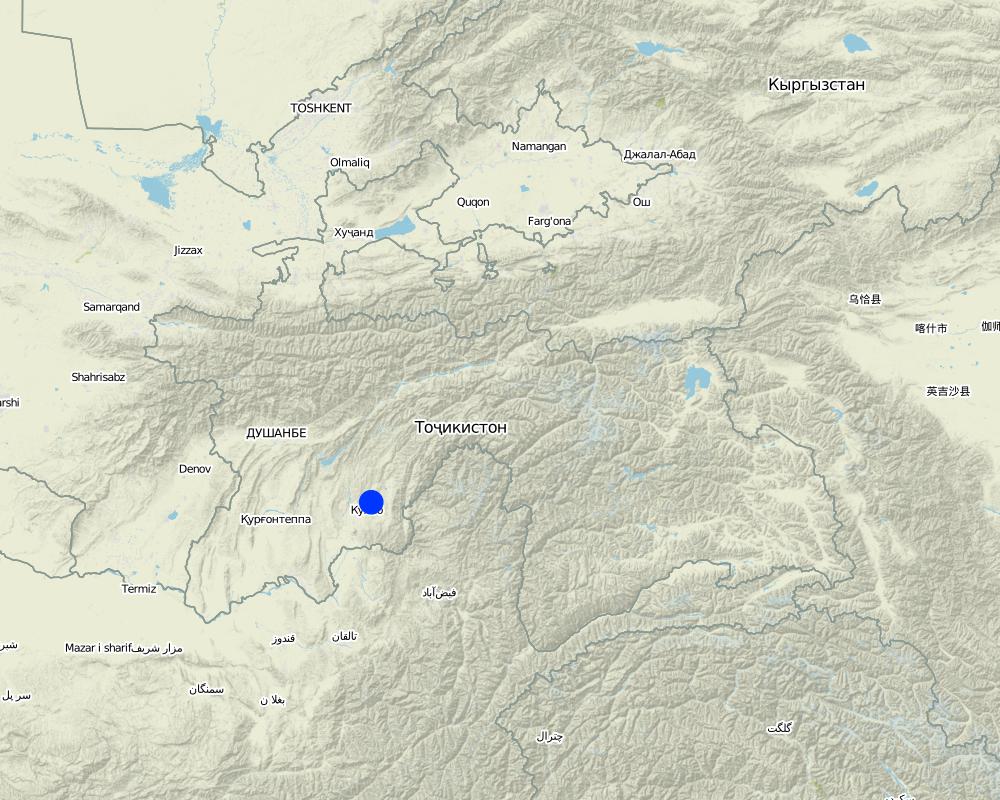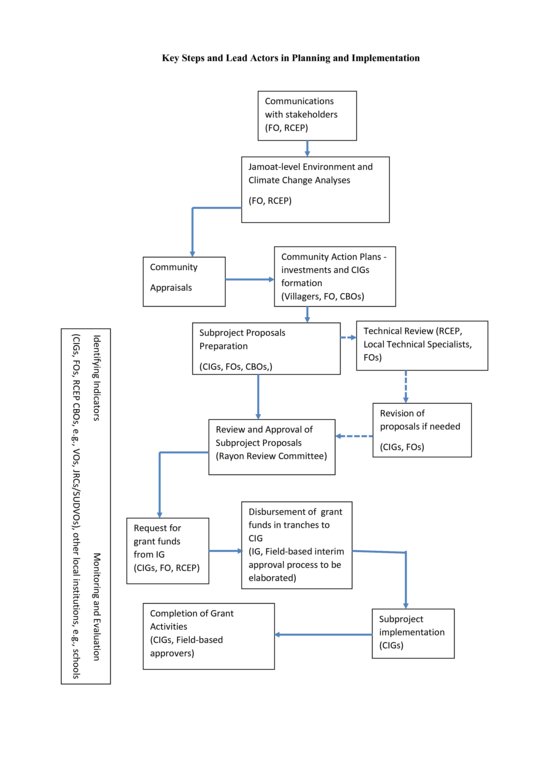Veterinary clinic contributing to the health level of the livestock and improved pastures through prevention activities [ຕາຈິກິສະຕານ]
- ການສ້າງ:
- ປັບປູງ:
- ຜູ້ສັງລວມຂໍ້ມູນ: Kamolidin Abdulloev
- ບັນນາທິການ: –
- ຜູ້ທົບທວນຄືນ: Farrukh Nazarmavloev
Дорухонаи байтори
approaches_3903 - ຕາຈິກິສະຕານ
ເບິ່ງພາກສ່ວນ
ຂະຫຍາຍທັງໝົດ ຍຸບທັງໝົດ1. ຂໍ້ມູນທົ່ວໄປ
1.2 ລາຍລະອຽດ ການຕິດຕໍ່ ຂອງບຸກຄົນທີ່ຊັບພະຍາກອນ ແລະ ສະຖາບັນ ການມີສ່ວນຮ່ວມ ໃນການປະເມີນຜົນ ແລະ ເອກະສານ ຂອງວິທີທາງ
ຊື່ຂອງໂຄງການ ທີ່ອໍານວຍຄວາມສະດວກ ໃນການສ້າງເອກກະສານ ຫຼື ປະເມີນດ້ານແນວທາງ (ຖ້າກ່ຽວຂ້ອງ)
Environmental Land Management and Rural Livelihoods (ELMAR)ຊື່ຂອງ ສະຖາບັນການຈັດຕັ້ງ ທີ່ອໍານວຍຄວາມສະດວກ ໃນການສ້າງເອກກະສານ ຫຼື ປະເມີນແນວທາງ (ຖ້າກ່ຽວຂ້ອງ)
Committee for Environment Protection of Tajikistan (Committee for Environment Protection of Tajikistan) - ຕາຈິກິສະຕານ1.3 ເງື່ອນໄຂ ຂອງການນໍາໃຊ້ເອກກະສານຂໍ້ມູນ ຂອງ WOCAT
ເມື່ອໃດທີ່ໄດ້ສັງລວມຂໍ້ມູນ (ຢູ່ພາກສະໜາມ)?
24/06/2018
ຜູ້ສັງລວມ ແລະ ບັນດາຜູ້ຕອບແບບສອບຖາມ ຍອມຮັບໃນເງື່ອນໄຂ ການນໍາໃຊ້ຂໍ້ມູນເອກະສານ ທີ່ສ້າງຂື້ນ ໂດຍຜ່ານ ອົງການ WOCAT:
ແມ່ນ
2. ພັນລະນາ ແນວທາງການຄຸ້ມຄອງນໍາໃຊ້ດິນແບບຍືນຍົງ
2.1 ການອະທິບາຍ ໂດຍຫຍໍ້ ຂອງວິທີທາງ
Improvement of the level of care and breeding cattle by opening a veterinary drugstore by this way to support livestock keepers somehow control pastures lands and livestock quantity
2.2 ການອະທິບາຍ ລາຍລະອຽດ ຂອງວິທີທາງ
ການອະທິບາຍ ລາຍລະອຽດ ຂອງວິທີທາງ:
Animal diseases would not mention by livestock keepers as a problem. Likely because they themselves perceive the present losses as unavoidable. The veterinary staff, however, estimates the annual losses of livestock due to diseases at 5-10%. Reasons given for this is that vaccines are often not made available for entire herd populations, but are only sufficient for around 70% of the total number of animals. Furthermore are some vaccination only carried out in case of an outbreak of disease (ring vaccination) and not as a routine. It was also noted that the privatization of veterinary services is problematic as the taxation of services is making it difficult for the vets in the rural areas to make a living out of their service provision. According to data infections diseases, such as gangrene, foot and mouth disease, brucellosis and other infectious diseases were registered in this rural area so depending on the season monitoring is conducted. Except for infectious diseases, there are other parasites infections are met in this rural area. In the case of not carrying out vaccination in a timely manner they will be spread, as well as failure to timely prevent other diseases leads to the loss of livestock, which will also reduce the economic level of the population and their living. This was the first problem, the second and the main is the balancing of fodder and livestock, and only villagers need to discuss how either the production of fodder can be increased or the number of animals can be reduced in order to achieve the potential production level of the animals, for which balancing fodder and number of livestock is a precondition. There are several options for how the balance between fodder and animals can be restored. The villagers need to have a plan and it would stipulate controlled grazing measures, this group does not have a plan but they some of the prevention activities. As the result of the approach, they opened livestock registered book that they regularly monitored the number of the livestock, calendar with the type of disease season, breeding process, mortality of the livestock, artificial insemination of animals at the clinic is planned to open, and species of birds. Additionally, vet clinic group specialists have been trained a different type of the training on; pasture assessment practical, how to develop and implement a scheme for rotational grazing, how to monitor potential pasture yields, determining the quality of fodder and feeds, housing process and so on. On behalf of the project for the representatives all the groups been provided composting, mulching, managing salinization, intercropping on slopes, drip irrigation, low-cost watering techniques, solar greenhouses, drought-resistant crops, bee-keeping, mixed fruit orchards, local varieties nurseries, rotational grazing, livestock breeding and maintaining, strategic watering points, use of perennial forage, solar energy technologies, marketing options and opportunities trainings through the facilitation organisation
2.3 ຮູບພາບຂອງແນວທາງ
2.5 ປະເທດ / ເຂດ / ສະຖານທີ່ບ່ອນທີ່ແນວທາງໄດ້ຖືກນໍາໃຊ້
ປະເທດ:
ຕາຈິກິສະຕານ
ພາກພື້ນ / ລັດ / ແຂວງ:
Kulob Region, Kulob District
ຂໍ້ມູນເພີ່ມເຕີມຂອງສະຖານທີ່:
Ziraki Jamoat, Gulbogh Village
ຄວາມຄິດເຫັນ:
An approach implemented in Kulob district, Jamoat Ziraki, Gubogh village
Map
×2.6 ວັນທີເລີ່ມຕົ້ນ ແລະ ສິ້ນສຸດ ການຈັດຕັ້ງປະຕີບັດ ວິທີທາງ
ສະແດງປີຂອງການເລີ່ມຕົ້ນ:
2015
ປີທີ່ສີ້ນສູດ (ຖ້າຢຸດບໍ່ໄດ້ນໍາໃຊ້ ວິທີທາງ):
2017
ຄວາມຄິດເຫັນ:
While carrying out preventive measures and treatment of farm animals rural people spend their service fees for the purchase of medicines and equipment. In the future, the head of the group is responsible to care of and make the veterinary clinic operation more sustainable.
2.7 ປະເພດຂອງແນວທາງ
- ພາຍໃຕ້ໂຄງການ / ແຜນງານ
2.8 ເປົ້າໝາຍ / ຈຸດປະສົງຫຼັກ ຂອງການຈັດຕັ້ງປະຕິບັດ ວິທີທາງ
The main goal of approach is to prevent infectious diseases of animals in a timely manner and infection of domestic animals, as well as to provide treatment and preventive measures for infectious diseases, such as immunization of cattle and small cattle and improving pasture lands through prevention activities
2.9 ເງື່ອນໄຂອໍານວຍ ຫຼື ຂັດຂວາງການປະຕິບັດຂອງເຕັກໂນໂລຢີ / ເຕັກໂນໂລຢີການນໍາໃຊ້ຕາມແນວທາງ
ສັງຄົມ / ວັດທະນະທໍາ / ມາດຕະຖານ ແລະ ຄຸນຄ່າທາງສາສະໜາ
- ເຊື່ອງຊ້ອນ
Besides, to purchase and increase good breeds of cattle adapted to the climate in this region. It is worth to note that the rural people were not aware of veterinary information. That resulted in that infectious diseases were spread because the population had eaten meat or sold in the market. Along with the implementation of this subproject these problems are disappearing.
ການກໍ່ຕັ້ງສະຖາບັນ
- ເຊື່ອງຊ້ອນ
Non of institutions was functionedThe CIG head is Isroil Nazarov and an accountant is Hussein Abdurahmonov. They are responsible for the subproject activities implementation, make all their efforts and put their enthusiasm for the successful implementation. While carrying out preventive measures and treatment of farm animals rural people spend their service fees for the purchase of medicines and equipment. In the future, the head of the group is responsible to care of and make the veterinary clinic operation more sustainable.
ຄວາມຮູ້ກ່ຽວກັບການຄຸ້ມຄອງ ທີ່ດິນແບບຍືນຍົງ, ການເຂົ້າເຖິງການສະໜັບສະໜູນ ທາງດ້ານວິຊາການ
- ເຊື່ອງຊ້ອນ
The livestock keepers and land users does not have sufficient knowledge to manage their lands On behalf of the project for the reprezentatives all the groups been provided composting, mulching, managing salinization, inter cropping on slopes, drip irrigation, low-cost watering techniques, solar greenhouses, drought resistant crops, bee-keeping, mixed fruit orchards, local varieties nurseries, rotational grazing, livestock breeding and maintaining, strategic watering points, use of perennial forage, solar energy technologies, marketing options and opportunities trainings through the facilitation organisation
3. ການມີສ່ວນຮ່ວມ ແລະ ບົດບາດຂອງພາກສ່ວນທີ່ກ່ຽວຂ້ອງທີ່ໄດ້ມີສ່ວນຮ່ວມ
3.1 ຜູ້ມີສ່ວນຮ່ວມ ໃນວິທີທາງ ແລະ ພາລະບົດບາດ ຂອງເຂົາເຈົ້າ
- ຜູ້ນໍາໃຊ້ດິນໃນທ້ອງຖິ່ນ / ຊຸມຊົນທ້ອງຖິ່ນ
CIG Members
The CIG head is Isroil Nazarov and an accountant is Hussein Abdurahmonov. They are responsible for the subproject activities implementation, make all their efforts and put their enthusiasm for the successful implementation. While carrying out preventive measures and treatment of farm animals rural people spend their service fees for the purchase of medicines and equipment. In the future, the head of the group is responsible to care of and make the veterinary clinic operation more sustainable.
- ຜູ້ຊ່ຽວຊານ ການນຄຸ້ມຄອງ ທີ່ດິນແບບຍືນຍົງ / ທີ່ປຶກສາດ້ານກະສິກໍາ
FOs and Academys
Reprezentatives been involved during the TOT trainings
- ອົງການຈັດຕັ້ງ ທີ່ບໍ່ຂື້ນກັບລັດຖະບານ
FOs
FOs provided their services to facilitate community mobilization, and preparation and implementation of sub-projects, as well as to strengthen the capacity of community based groups to undertake their respective project responsibilities
- ອໍານາດ ການປົກຄອງທ້ອງຖິ່ນ
Local hukumat and Jamoat
Jamoat representatives was involved in Participatory Rural Appraisal (PRA) that was used as the main pre-assessment mechanism to analyze socio-economic and environmental situation in the selected pilots, The RRC(Rayon Reviw Committee) will consider the combination of proposed sub-projects within the overall context of the rayon and project.
3.2 ການມີສ່ວນຮ່ວມຂອງຜູ້ນໍາໃຊ້ທີ່ດິນໃນທ້ອງຖິ່ນ / ຊຸມຊົນທ້ອງຖິ່ນໃນໄລຍະທີ່ແຕກຕ່າງກັນຂອງແນວທາງ
| ການລວບລວມ ເອົາຜູ້ນໍາໃຊ້ດິນ ໃນທ້ອງຖິ່ນ / ຊຸມຊົນທ້ອງຖິ່ນ | ໃຫ້ລະບຸ ຜູ້ໃດທີ່ມີສ່ວນຮ່ວມ ໃນແຕ່ລະກິດຈະກໍາ? | |
|---|---|---|
| ການເລີ່ມຕົ້ນ / ແຮງຈູງໃຈ | ການຮ່ວມມື | There are 274 households residing in the village with the total number of 2225 people. The CIG head is Isroil Nazarov. He is as the specialist responsible for the subproject/approach activities implementation, make all their efforts and put their enthusiasm for the successful implementation |
| ການວາງແຜນ | ການບໍ່ປະຕິບັດ | The local land users prioritized investments based on a fixed budget for each type of rural investment determined by the number of households and on behalf of the CAP participants decided on the allocation of investments to groups of households (Common Interest Groups, CIGs) using rules that limit the funding for any one household. At least 50% of the village households should participate in either farm production or land resource management investments. |
| ການປະຕິບັດ | ການຮ່ວມມື | Villagers made grant allocation decisions. CIGs managed grant funds and purchased needed materials and products. |
| ຕິດຕາມກວດກາ / ການປະເມີນຜົນ | ການບໍ່ປະຕິບັດ | Local land users have activelly participated during the monitoring |
3.3 ແຜນວາດ (ຖ້າມີ)
ການອະທິບາຍ:
Here is the key steps and actors in the planning and implementation of rural investments. Not all possible participants in these steps are included since local situations may vary and will need to be taken into account during planning and implementation.
ຜູ້ຂຽນ:
ELMARL POM
3.4 ການຕັດສິນໃຈກ່ຽວກັບການຄັດເລືອກເຕັກໂນໂລຢີຂອງການຄຸ້ມຄອງທີ່ດິນແບບຍືນຍົງ / ເຕັກໂນໂລຢີ
ລະບຸ ຄົນທີ່ຕັດສິນໃຈ ກ່ຽວກັບການຄັດເລືອກຂອງ ເຕັກໂນໂລຢີ / ເຕັກໂນໂລຢີ ຈະໄດ້ຮັບການປະຕິບັດ:
- ຜູ້ນໍາໃຊ້ທີ່ດິນຫຼັກ, ການສະໜັບສະໜູນ ໂດຍຜູ້ຊ່ຽວຊານ ການນໍາໃຊ້ທີ່ດິນແບບຍືນຍົງ
ອະທິບາຍ:
The local land users prioritized investments based on a fixed budget for each type of rural investment determined by the number of households and on behalf of the CAP participants decided on the allocation of investments to groups of households (Common Interest Groups, CIGs) using rules that limit the funding for any one household
Specify on what basis decisions were made:
- ປະເມີນເອກກະສານ ຄວາມຮູ້ກ່ຽວກັບ ການຄຸ້ມຄອງ ທີ່ດິນແບບຍືນຍົງ (ຫຼັກຖານທີ່ຊ່ວຍໃນການຕັດສິນໃຈ)
- Project initial phases
4. ການສະໜັບສະໜູນທາງດ້ານວິຊາການ, ການສ້າງຄວາມສາມາດ, ແລະ ການຈັດການຄວາມຮູ້.
4.1 ການສ້າງຄວາມສາມາດ / ການຝຶກອົບຮົມ
ຜູ້ນໍາໃຊ້ທີ່ດິນ ຫຼື ພາກສ່ວນກ່ຽວຂ້ອງອື່ນໆ ໄດ້ຮັບການຝຶກອົບຮົມບໍ່?
ແມ່ນ
ໃຫ້ລະບຸ ຜູ້ໃດທີ່ໄດ້ຮັບການຝຶກອົບຮົມ:
- ຜູ້ນໍາໃຊ້ດິນ
- ພະນັກງານພາກສະໜາມ / ທີ່ປຶກສາ
ຖ້າເປັນໄປໄດ້, ໃຫ້ລະບຸເພດ, ອາຍຸ, ສະຖານະພາບ, ຊົນເຜົ່າ, ແລະ ອື່ນໆ:
Provided participation of the male and female during the training process
ຮູບແບບຂອງການຝຶກອົບຮົມ:
- ການເຮັດຕົວຈິງ
- ຕົວຕໍ່ຕົວ
- ກອງປະຊຸມ
ໃນຫົວຂໍ້:
Grant allocation mechanisms. Fund flow arrangements, management and technical
ຄວາມຄິດເຫັນ:
Trainings included such king themes; composting, mulching, managing salinization, intercropping on slopes, drip irrigation, low-cost watering techniques, solar greenhouses, drought-resistant crops, bee-keeping, mixed fruit orchards, local varieties nurseries, rotational grazing, Livestock breeding and maintaining, strategic watering points, use of perennial forage, solar energy technologies, marketing options and opportunities,
4.2 ການບໍລິການໃຫ້ຄໍາປຶກສາ
ເຮັດຜູ້ໃຊ້ທີ່ດິນມີການເຂົ້າເຖິງການບໍລິການໃຫ້ຄໍາປຶກສາ?
ແມ່ນ
ລະບຸວ່າການສະໜອງ ການບໍລິການ ໃຫ້ຄໍາປຶກສາ:
- ໃນພື້ນທີ່ຂອງຜູ້ນໍາໃຊ້ດິນ
- ສູນຄົ້ນຄວ້າ
ອະທິບາຍ / ຄວາມຄິດເຫັນ:
Jamoat representatives and also local vet specialists from the district advise them
4.3 ສະຖາບັນການສ້າງຄວາມເຂັ້ມແຂງ (ການພັດທະນາອົງການຈັດຕັ້ງ)
ສະຖາບັນ ໄດ້ຮັບການສ້າງຕັ້ງຂື້ນ ຫຼື ໄດ້ຮັບການສ້າງຄວາມເຂັ້ມແຂງ ໂດຍການຈັດຕັ້ງປະຕິບັດ ວິທີທາງບໍ່?
- ມີ, ໜ້ອຍໜຶ່ງ
ລະບຸ ທາງສະຖາບັນ ໄດ້ສ້າງຄວາມເຂັ້ມແຂງ ໃນລະດັບໃດ (ຫຼາຍ):
- ທ້ອງຖິ່ນ
ອະທິບາຍ ສະຖາບັນການຈັດຕັ້ງ, ພາລະບົດບາດ ແລະ ໜ້າທີ່ຮັບຜິດຊອບ, ສະມາຊິກ ແລະ ອື່ນໆ.
The Common Interest Groups formed in the villages on behalf households and enhanced their knowledge. And the project provides small-scale grants at the village level for groups of households (CIG) to implement rural production and land management investments, as well as related small-scale infrastructure investments. Villages will prioritize investments based on a fixed budget for each type of rural investment, determined by the number of households.
ລະບຸ ປະເພດ ຂອງສະໜັບສະໜູນ:
- ທາງດ້ານການເງິນ
- ການສ້າງຄວາມອາດສາມາດ / ການຝຶກອົບຮົມ
ໃຫ້ລາຍລະອຽດເພີ່ມເຕີມ:
Project-financed grants to CIGs for each investment under categories of rural production and land management investments, as well as related small-scale infrastructure investments that will not exceed US$7,000 and will require a match of 25% in beneficiary contributions which may be in cash or in-kind
4.4 ຕິດຕາມກວດກາ ແລະ ປະເມີນຜົນ
ການຈັດຕັ້ງປະຕິບັດ ວິທີທາງ ໄດ້ມີການປະເມີນຜົນ ແລະ ຕິດຕາມບໍ?
ບໍ່ແມ່ນ
4.5 ການຄົ້ນຄວ້າ
ນີ້້ແມ່ນສ່ວນໜຶ່ງ ການຄົ້ນຄວ້າ ຂອງວິທີທາງບໍ່?
ບໍ່ແມ່ນ
5. ການສະໜັບສະໜູນທາງດ້ານການເງິນ ແລະ ອຸປະກອນຈາກພາຍນອກ
5.1 ງົບປະມານປະຈໍາປີ ສໍາລັບວິທີທາງ ຂອງການຄຸ້ມຄອງ ທີ່ດິນແບບຍືນຍົງ
ຖ້າຫາກບໍ່ຮູ້ຈັດງົບປະມານທີ່ແນ່ນອນ ແມ່ນໃຫ້ປະມານເອົາ:
- 2,000-10,000
ຄໍາເຫັນ (ຕົວຢ່າງ: ແຫຼ່ງຂໍ້ມູນຫຼັກ ຂອງການສະໜອງທຶນ / ຜູ້ໃຫ້ທຶນທີ່ສໍາຄັນ):
GEF/PPCR through the WB
5.2 ການສະໜັບສະໜູນ ທາງດ້ານການເງິນ / ອຸປະກອນ ສະໜອງໃຫ້ແກ່ຜູ້ນໍາທີ່ດິນ
ຜູ້ນໍາໃຊ້ດິນ ໄດ້ຮັບການສະໜັບສະໜູນ ທາງດ້ານ ການເງິນ / ອຸປະກອນ ໃນການຈັດຕັ້ງປະຕິບັດ ເຕັກໂນໂລຢີບໍ?
ແມ່ນ
ຖ້າແມ່ນ, ໃຫ້ລະບຸປະເພດ (ຫຼາຍ) ຂອງການສະໜັບສະໜູນ, ເງື່ອນໄຂ ແລະ ຜູູ້ສະໜອງ (ຫຼາຍ):
The project will finance investments in three categories that are expected to improve household assets and sustainable land management, and build climate resilience, examples ofwhich are listed below: (i) Farm Production: field and horticultural crop productivity and diversity (e.g., crop rotations, drought resistant varieties, diversified cropping regimes, community seed funds, low-cost greenhouses), livestock production efficiency (e.g., breed choice, veterinary services), agro-processing and market access;(ii) Land Resource Management: pasture management (e.g., fodder productivity through appropriate species, rotational grazing, watering holes, growing perennials on slopes), watermanagement (e.g., drip irrigation and similar measures, water harvesting), soil fertility (e.g.,composting, mulch crops) integrated pest management (e.g., use of pheromone traps,biological controls) and sustainable sloping lands cultivation (including terracing, inter cropped orchards and woodlots, shelter-belts); and (iii) Small-scale Rural Production Infrastructure: irrigation/drainage system rehabilitation, minor transport infrastructure rehabilitation (e.g., repair of bridges), renewable energy (e.g.,low cost solar energy, and energy efficiency measures (e.g., improved stoves, insulation).Project-financed grants to CIGs for each investment under categories (i), (ii), and (iii) will not exceed US$7,000 and will require a match of 25% in beneficiary contributions which may be in cash or in-kind. Beneficiaries of rural infrastructure investments (category iii above) will have to contribute at least 5% of the total cost in cash at inception. Grants under this subcomponent will be disbursed in tranches directly to beneficiaries or groups to their own bank account with Amonatbank that has branches in most districts.
5.3 ເງິນສົມທົບສໍາລັບການນໍາໃຊ້ສະເພາະປັດໃຈຂາເຂົ້າໃນການຜະລີດກະສິກໍາ (ລວມທັງແຮງງານ)
- ບໍ່ມີ
ຖ້າແຮງງານ ຂອງຜູ້ນໍາໃຊ້ດິນ ໄດ້ຮັບການສະໜັບສະໜູນ ປັດໃຈຂາເຂົ້າ, ແມ່ນບໍ່:
- ການອາສາ
ຄວາມຄິດເຫັນ:
The CIG group contributed more then 25 % from the total subproject/approach
5.4 ສິນເຊື່ອ
ໄດ້ປ່ອຍສິນເຊື່ອ ສະໜອງໃຫ້ພາຍໃຕ້ ວິທີການສໍາລັບກິດຈະກໍາ ການຄຸ້ມຄອງ ທີ່ດິນແບບຍືນນຍົງບໍ່?
ບໍ່ແມ່ນ
5.5 ສິ່ງຈູງໃຈ ຫຼື ເຄື່ອງມືອື່ນໆ
ການສົ່ງເສີມ ຈັດຕັ້ງປະຕິບັດ ເຕັກໂນໂລຢີ ໃນການຄຸ້ມຄອງ ດິນແບບຍືນຍົງ ໄດ້ສະໜອງສິ່ງກະຕຸກຊຸກຍູ້ບໍ່?
ບໍ່ແມ່ນ
6. ວິເຄາະຜົນກະທົບ ແລະ ສັງລວມບັນຫາ
6.1 ຜົນກະທົບຂອງແນວທາງ
ວິທີທາງ ຊ່ວຍຊຸກຍູ້ ຜູ້ນຳໃຊ້ທີ່ດິນທ້ອງຖີ່ນ, ໃນການປັບປຸງ ການມີສ່ວນຮ່ວມ ຂອງຜູ້ທີ່ກ່ຽວຂ້ອງ ບໍ່?
- ບໍ່
- ມີ, ໜ້ອຍໜຶ່ງ
- ມີ, ພໍສົມຄວນ
- ມີ, ຫຼາຍ
There are 274 households residing in the village with total number of 2225 people. The CIG head is Isroil Nazarov and an accountant is Hussein Abdurahmonov. They are responsible for the subproject activities implementation, make all their efforts and put their enthusiasm for the successful implementation. While carrying out preventive measures and treatment of farm animals rural people spend their service fees for the purchase of medicines and equipment. In the future, the head of the group is responsible to care of and make the veterinary clinic operation more sustainable
On behalf of the project for the reprezentatives all the groups been provided composting, mulching, managing salinization, inter cropping on slopes, drip irrigation, low-cost watering techniques, solar greenhouses, drought resistant crops, bee-keeping, mixed fruit orchards, local varieties nurseries, rotational grazing, livestock breeding and maintaining, strategic watering points, use of perennial forage, solar energy technologies, marketing options and opportunities trainings through the facilitation organisation that will contribute to implement and maitain apprach
ການນໍາໃຊ້ ວິທີທາງ ສາມາດປັບປຸງຄວາມຮູ້ ແລະ ຄວາມສາມາດຂອງຜູ້ນໍາໃຊ້ທີ່ດິນ ໃນການປະຕິບັດ ການຄຸ້ມຄອງ ທີ່ດິນແບບຍືດຍົງໄດ້ບໍ່?
- ບໍ່
- ມີ, ໜ້ອຍໜຶ່ງ
- ມີ, ພໍສົມຄວນ
- ມີ, ຫຼາຍ
Trainings were organized and most of them had direct and indirect relation to SLM projects
6.2 ແຮງຈູງໃຈຫຼັກຂອງຜູ້ນໍາໃຊ້ທີ່ດິນໃນການປະຕິບັດການຄຸ້ມຄອງທີ່ດິນແບບຍືນຍົງ
- ການຜະລິດເພີ່ມຂຶ້ນ
The vet specialists will advise livestock keepers regarding the new breeds and also the timely manner of the vaccination process will contribute to the productivity of the livestock
- ຫຼຸດຜ່ອນດິນເຊື່ອມໂຊມ
As the result of the approach, they opened livestock registered book that they regularly monitored the number of the livestock, calendar with the type of disease season, breeding process, mortality of the livestock, artificial insemination of animals at the clinic is planned to open, and species of birds. Additionally, vet clinic group specialists have been trained a different type of the training on; pasture assessment practical, how to develop and implement a scheme for rotational grazing, how to monitor potential pasture yields, determining the quality of fodder and feeds, housing process training will contribute to reducing degradation in pastures.
- ການປັບປຸງ ຄວາມຮູ້ ແລະ ຄວາມສາມາດ ຂອງການຄຸ້ມຄອງ ທີ່ດິນແບບຍືນຍົງ
There were organised a huge number of different type of trainings that are all were relative to the SLM
6.3 ຄວາມຍືນຍົງຂອງກິດຈະກໍາວິທີທາງ
ຜູ້ນໍາໃຊ້ ທີ່ດິນ ສາມາດສືບຕໍ່ ການຈັດຕັ້ງປະຕິບັດ ຜ່ານວິທີທາງໄດ້ບໍ່ (ໂດຍປາດສະຈາກ ການຊ່ວຍເຫຼືອ ຈາກພາກສ່ວນພາຍນອກ)?
- ແມ່ນ
ຖ້າ ໄດ້, ອະທິບາຍເຫດຜົນ:
The CIG head is Isroil Nazarov and an accountant is Hussein Abdurahmonov. They are responsible for the subproject activities implementation, make all their efforts and put their enthusiasm for the successful implementation. While carrying out preventive measures and treatment of farm animals rural people spend their service fees for the purchase of medicines and equipment. In the future, the head of the group is responsible to care of and make the veterinary clinic operation more sustainable.
6.4 ຈຸດແຂງ / ຂໍ້ດີ ຂອງວິທີທາງ
| ຈຸດແຂງ / ຈຸດດີ / ໂອກາດ ຈາກທັດສະນະຂອງຜູ້ປ້ອນຂໍ້ມູນ ຫຼື ບຸກຄົນສຳຄັນ |
|---|
| High-qualified specialists in the group |
| Office speace, where they will be able to conduct meetings with the farmers |
| Required knowledge |
6.5 ຈຸດອ່ອນ / ຂໍ້ເສຍຂອງແນວທາງ ແລະ ວິທີການແກ້ໄຂໃຫ້ເຂົາເຈົ້າ
| ຈຸດອ່ອນ ຫຼື ຂໍ້ເສຍ ຫຼື ຄວາມສ່ຽງ ໃນມຸມມອງຂອງ ຜູ້ສັງລວມຂໍ້ມູນ ຫຼື ບັນດາຜູ້ຕອບແບບສອບຖາມ | ມີວິທີການແກ້ໄຂຄືແນວໃດ? |
|---|---|
| Knowledge on the market analysis, fundraising, business planning | They need additional support on capacity building |
| Support on behalf of the district local government | They need to work more closely with the district and local government |
| New sources to go ahead | The group needs to come up with the requested letters to the sufficient donors or government funds |
7. ເອກກະສານອ້າງອີງ ແລະ ຂໍ້ມູນການເຊື່ອມໂຍງ
7.1 ວິທີການ / ແຫຼ່ງຂໍ້ມູນ
- ການສໍາພາດ ຜູ້ນໍາໃຊ້ທີ່ດິນ
CIG Members
- ສໍາພາດ ຊ່ຽວຊານ ການຄຸ້ມຄອງ ດິນແບບຍືນຍົງ
ELMARL Specialists
7.2 ເອກະສານທົ່ວໄປທີ່ສາມາດໃຊ້ໄດ້
ຫົວຂໍ້, ຜູ້ຂຽນ, ປີ, ISBN:
ELMARL Annual Report 2017
ມີຢູ່ໃສ?ມູນຄ່າເທົ່າໃດ?
Committee of Environment Protection of RT.
7.3 ການເຊື່ອມຕໍ່ກັບຂໍ້ມູນທີ່ກ່ຽວຂ້ອງທີ່ສາມາດໃຊ້ອອນໄລນ໌
ຫົວຂໍ້ / ພັນລະນາ:
ELMARL documents on SLM Knowledge Management platform
URL:
https://slmtj.net
ຂໍ້ມູນການເຊື່ອມຕໍ່ ແລະ ເນື້ອໃນ
ຂະຫຍາຍທັງໝົດ ຍຸບທັງໝົດການເຊື່ອມຕໍ່
ບໍ່ມີຂໍ້ມູນການເຊື່ອມຕໍ່
ເນື້ອໃນ
ບໍ່ມີເນື້ອໃນ


